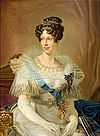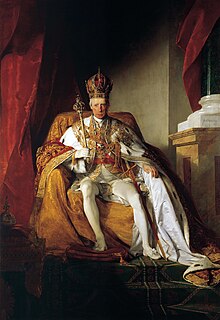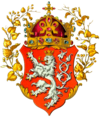Francis II, Holy Roman Emperor
Francis II (German: Franz; 12 February 1768 – 2 March 1835) was the last Holy Roman Emperor, ruling from 1792 until 6 August 1806, when he dissolved the Holy Roman Empire of the German Nation after the decisive defeat at the hands of the First French Empire led by Napoleon at the Battle of Austerlitz. In 1804, he had founded the Austrian Empire and became Francis I, the first Emperor of Austria, ruling from 1804 to 1835, so later he was named the one and only Doppelkaiser (double emperor) in history.[1] For the two years between 1804 and 1806, Francis used the title and style by the Grace of God elected Roman Emperor, ever Augustus, hereditary Emperor of Austria and he was called the Emperor of both the Holy Roman Empire and Austria. He was also Apostolic King of Hungary and Bohemia as Francis I. He also served as the first president of the German Confederation following its establishment in 1815.
Francis II continued his leading role as an opponent of Napoleonic France in the Napoleonic Wars, and suffered several more defeats after Austerlitz. The proxy marriage of state of his daughter Marie Louise of Austria to Napoleon on 10 March 1810 was arguably his most severe personal defeat. After the abdication of Napoleon following the War of the Sixth Coalition, Austria participated as a leading member of the Holy Alliance at the Congress of Vienna, which was largely dominated by Francis's chancellor Klemens Wenzel, Prince von Metternich culminating in a new European map and the restoration of Francis's ancient dominions (except the Holy Roman Empire which was dissolved). Due to the establishment of the Concert of Europe, which largely resisted popular nationalist and liberal tendencies, Francis became viewed as a reactionary later in his reign.
Early life

Francis was a son of Emperor Leopold II (1747–1792) and his wife Maria Luisa of Spain (1745–1792), daughter of Charles III of Spain. Francis was born in Florence, the capital of Tuscany, where his father reigned as Grand Duke from 1765–90. Though he had a happy childhood surrounded by his many siblings,[2] his family knew Francis was likely to be a future Emperor (his uncle Joseph had no surviving issue from either of his two marriages), and so in 1784 the young Archduke was sent to the Imperial Court in Vienna to educate and prepare him for his future role.[3]
Emperor Joseph II himself took charge of Francis's development. His disciplinarian regime was a stark contrast to the indulgent Florentine Court of Leopold. The Emperor wrote that Francis was "stunted in growth", "backward in bodily dexterity and deportment", and "neither more nor less than a spoiled mother's child". Joseph concluded that "the manner in which he was treated for upwards of sixteen years could not but have confirmed him in the delusion that the preservation of his own person was the only thing of importance".[3]
Joseph's martinet method of improving the young Francis were "fear and unpleasantness".[4] The young Archduke was isolated, the reasoning being that this would make him more self-sufficient as it was felt by Joseph that Francis "failed to lead himself, to do his own thinking". Nonetheless, Francis greatly admired his uncle, if rather feared him. To complete his training, Francis was sent to join an army regiment in Hungary and he settled easily into the routine of military life.[5]
After the death of Joseph II in 1790, Francis's father became Emperor. He had an early taste of power while acting as Leopold's deputy in Vienna while the incoming Emperor traversed the Empire attempting to win back those alienated by his brother's policies.[6] The strain tolled on Leopold and by the winter of 1791, he became ill. He gradually worsened throughout early 1792; on the afternoon of 1 March Leopold died, at the relatively young age of 44. Francis, just past his 24th birthday, was now Emperor, much sooner than he had expected.
Emperor

As the leader of the large multi-ethnic Habsburg Empire, Francis felt threatened by Napoleon's social and political reforms, which were being exported throughout Europe with the expansion of the first French Empire. Francis had a fraught relationship with France. His aunt Marie Antoinette, the wife of Louis XVI and Queen consort of France, was guillotined by the revolutionaries in 1793, at the beginning of his reign. Francis, on the whole, was indifferent to her fate (she was not close to his father, Leopold, and although Francis had met her, he had been too young at the time to have any memory of his aunt). Georges Danton attempted to negotiate with the Emperor for Marie Antoinette's release, but Francis was unwilling to make any concessions in return.[7]
Later, he led Austria into the French Revolutionary Wars. He briefly commanded the Allied forces during the Flanders Campaign of 1794 before handing over command to his brother Archduke Charles. He was later defeated by Napoleon. By the Treaty of Campo Formio, he ceded the left bank of the Rhine to France in exchange for Venice and Dalmatia. He again fought against France during the Second and Third Coalition, when after meeting a crushing defeat at Austerlitz, he had to agree to the Treaty of Pressburg, weakening the Austrian Empire and reorganizing Germany under a Napoleonic imprint that would be called the Confederation of the Rhine.

At this point, he believed his position as Holy Roman Emperor to be untenable, so on 6 August 1806, he abdicated the throne, declaring the empire to be already dissolved in the same declaration. This was a political move to impair the legitimacy of the Confederation of the Rhine.[8] He had anticipated losing the Holy Roman crown, however. Two years earlier, as a reaction to Napoleon making himself an emperor, he had raised Austria to the status of an empire. Hence, after 1806, he reigned as Francis I, Emperor of Austria.[9]
In 1809, Francis attacked France again, hoping to take advantage of the Peninsular War embroiling Napoleon in Spain. He was again defeated, and this time forced to ally himself with Napoleon, ceding territory to the Empire, joining the Continental System, and wedding his daughter Marie-Louise to the Emperor. The Napoleonic wars drastically weakened Austria, making it entirely landlocked and threatened its preeminence among the states of Germany, a position that it would eventually cede to the Kingdom of Prussia.
In 1813, for the fourth and final time, Austria turned against France and joined Great Britain, Russia, Prussia and Sweden in their war against Napoleon. Austria played a major role in the final defeat of France—in recognition of this, Francis, represented by Clemens von Metternich, presided over the Congress of Vienna, helping to form the Concert of Europe and the Holy Alliance, ushering in an era of conservatism in Europe. The German Confederation, a loose association of Central European states was created by the Congress of Vienna in 1815 to organize the surviving states of the Holy Roman Empire. The Congress was a personal triumph for Francis, who hosted the assorted dignitaries in comfort,[10] though Francis undermined his allies Tsar Alexander and Frederick William III of Prussia by negotiating a secret treaty with the restored French king Louis XVIII.[11]
Domestic policy

The violent events of the French Revolution impressed themselves deeply into the mind of Francis (as well as all other European monarchs), and he came to distrust radicalism in any form. In 1794, a "Jacobin" conspiracy was discovered in the Austrian and Hungarian armies.[12] The leaders were put on trial, but the verdicts only skirted the perimeter of the conspiracy. Francis's brother Alexander Leopold (at that time Palatine of Hungary) wrote to the Emperor admitting "Although we have caught a lot of the culprits, we have not really got to the bottom of this business yet." Nonetheless, two officers heavily implicated in the conspiracy were hanged and gibbeted, while numerous others were sentenced to imprisonment (many of whom died from the conditions).[13]
Francis was from his experiences suspicious and set up an extensive network of police spies and censors to monitor dissent[13] (in this he was following his father's lead, as the Grand Duchy of Tuscany had the most effective secret police in Europe).[3] Even his family did not escape attention. His brothers, the Archdukes Charles and Johann had their meetings and activities spied upon.[14] Censorship was also prevalent. The author Franz Grillparzer, a Habsburg patriot, had one play suppressed solely as a "precautionary" measure. When Grillparzer met the censor responsible, he asked him what was objectionable about the work. The censor replied, "Oh, nothing at all. But I thought to myself, 'One can never tell'."[15]

In military affairs Francis had allowed his brother, the Archduke Charles, extensive control over the army during the Napoleonic wars. Yet, distrustful of allowing any individual too much power, he otherwise maintained the separation of command functions between the Hofkriegsrat and his field commanders.[16] In the later years of his reign he limited military spending, requiring it not exceed forty million florins per year; because of inflation this resulted in inadequate funding, with the army's share of the budget shrinking from half in 1817 to only twenty-three percent in 1830.[17]
Francis presented himself as an open and approachable monarch (he regularly set aside two mornings each week to meet his imperial subjects, regardless of status, by appointment in his office, even speaking to them in their own language),[18] but his will was sovereign. In 1804, he had no compunction about announcing that through his authority as Holy Roman Emperor, he declared he was now Emperor of Austria (at the time a geographical term that had little resonance). Two years later, Francis personally wound up the moribund Holy Roman Empire of the German Nation. Both actions were of dubious constitutional legality.[19]
Later years

On 2 March 1835, 43 years and a day after his father's death, Francis died in Vienna of a sudden fever aged 67, in the presence of many of his family and with all the religious comforts.[20] His funeral was magnificent, with his Viennese subjects respectfully filing past his coffin in the chapel of Hofburg Palace[21] for three days.[22] Francis was interred in the traditional resting place of Habsburg monarchs, the Kapuziner Imperial Crypt in Vienna's Neue Markt Square. He is buried in tomb number 57, surrounded by his four wives.
Francis left a main point in the political testament he left for his son and heir Ferdinand to; "preserve unity in the family and regard it as one of the highest goods." In many portraits (particularly those painted by Peter Fendi) he was portrayed as the patriarch of a loving family, surrounded by his children and grandchildren.[20]
After 1806 he used the titles: "We, Francis the First, by the Grace of God Emperor of Austria; King of Jerusalem, Hungary, Bohemia, Dalmatia, Croatia, Slavonia, Galicia and Lodomeria; Archduke of Austria; Duke of Lorraine, Salzburg, Würzburg, Franconia, Styria, Carinthia and Carniola; Grand Duke of Cracow; Grand Prince of Transylvania; Margrave of Moravia; Duke of Sandomir, Masovia, Lublin, Upper and Lower Silesia, Auschwitz and Zator, Teschen and Friule; Prince of Berchtesgaden and Mergentheim; Princely Count of Habsburg, Gorizia and Gradisca and of the Tirol; and Margrave of Upper and Lower Lusatia and in Istria".
Heraldry
| Heraldry of Francis II, Holy Roman Emperor | ||||||
|---|---|---|---|---|---|---|
|
Ancestors
| Ancestors of Francis II, Holy Roman Emperor[23] | ||||||||||||||||||||||||||||||||||||||||||||||||||||||||||||||||||||||||||||||||||||||||||||||||||||||||||||||||||||||||||||||||||||||||||||||||||||||||||||||||||||||||||||||||||||||||||||||||||||||||||||||||||||||||||||||||||||||||||||||||||||||||||||||||||||||||||||||||||||||||||||||||||||||||||||||||||||||||||||||||||||||||||||||||||||||||||||||||||||||||||||||||||||||||||||||||||||||||||||||||||||||||||||||||||||||||||||||||||||||||||||||||||||||||||||||||||||||||||||||||||||||||||||||||||||||||||||||||||||||||||||||||||||||||||||||||||||||||||||||||||||||||||||||||||||||||||||||||
|---|---|---|---|---|---|---|---|---|---|---|---|---|---|---|---|---|---|---|---|---|---|---|---|---|---|---|---|---|---|---|---|---|---|---|---|---|---|---|---|---|---|---|---|---|---|---|---|---|---|---|---|---|---|---|---|---|---|---|---|---|---|---|---|---|---|---|---|---|---|---|---|---|---|---|---|---|---|---|---|---|---|---|---|---|---|---|---|---|---|---|---|---|---|---|---|---|---|---|---|---|---|---|---|---|---|---|---|---|---|---|---|---|---|---|---|---|---|---|---|---|---|---|---|---|---|---|---|---|---|---|---|---|---|---|---|---|---|---|---|---|---|---|---|---|---|---|---|---|---|---|---|---|---|---|---|---|---|---|---|---|---|---|---|---|---|---|---|---|---|---|---|---|---|---|---|---|---|---|---|---|---|---|---|---|---|---|---|---|---|---|---|---|---|---|---|---|---|---|---|---|---|---|---|---|---|---|---|---|---|---|---|---|---|---|---|---|---|---|---|---|---|---|---|---|---|---|---|---|---|---|---|---|---|---|---|---|---|---|---|---|---|---|---|---|---|---|---|---|---|---|---|---|---|---|---|---|---|---|---|---|---|---|---|---|---|---|---|---|---|---|---|---|---|---|---|---|---|---|---|---|---|---|---|---|---|---|---|---|---|---|---|---|---|---|---|---|---|---|---|---|---|---|---|---|---|---|---|---|---|---|---|---|---|---|---|---|---|---|---|---|---|---|---|---|---|---|---|---|---|---|---|---|---|---|---|---|---|---|---|---|---|---|---|---|---|---|---|---|---|---|---|---|---|---|---|---|---|---|---|---|---|---|---|---|---|---|---|---|---|---|---|---|---|---|---|---|---|---|---|---|---|---|---|---|---|---|---|---|---|---|---|---|---|---|---|---|---|---|---|---|---|---|---|---|---|---|---|---|---|---|---|---|---|---|---|---|---|---|---|---|---|---|---|---|---|---|---|---|---|---|---|---|---|---|---|---|---|---|---|---|---|---|---|---|---|---|---|---|---|---|---|---|---|---|---|---|---|---|---|---|---|---|---|---|---|---|---|---|---|---|---|---|---|---|---|---|---|---|---|---|---|---|---|---|---|---|---|---|---|---|---|---|---|---|---|---|---|---|---|---|---|---|---|---|---|---|---|---|---|---|---|---|---|---|---|---|---|---|---|---|---|---|---|---|---|---|---|---|---|---|---|---|---|---|---|---|---|---|---|---|---|---|---|---|---|---|---|---|---|---|---|---|---|---|---|---|---|---|---|---|---|---|---|---|---|---|---|---|---|---|---|---|---|---|---|---|---|---|---|---|---|---|---|---|---|---|---|---|---|---|---|---|
| ||||||||||||||||||||||||||||||||||||||||||||||||||||||||||||||||||||||||||||||||||||||||||||||||||||||||||||||||||||||||||||||||||||||||||||||||||||||||||||||||||||||||||||||||||||||||||||||||||||||||||||||||||||||||||||||||||||||||||||||||||||||||||||||||||||||||||||||||||||||||||||||||||||||||||||||||||||||||||||||||||||||||||||||||||||||||||||||||||||||||||||||||||||||||||||||||||||||||||||||||||||||||||||||||||||||||||||||||||||||||||||||||||||||||||||||||||||||||||||||||||||||||||||||||||||||||||||||||||||||||||||||||||||||||||||||||||||||||||||||||||||||||||||||||||||||||||||||||
Marriages
Francis II married four times:
- On 6 January 1788, to Elisabeth of Württemberg (21 April 1767 – 18 February 1790).
- On 15 September 1790, to his double first cousin Maria Teresa of the Two Sicilies (6 June 1772 – 13 April 1807), daughter of King Ferdinand I of the Two Sicilies (both were grandchildren of Empress Maria Theresa and shared all of their other grandparents in common), with whom he had twelve children, of whom only seven reached adulthood.
- On 6 January 1808, he married again to another first cousin, Maria Ludovika of Austria-Este (14 December 1787 – 7 April 1816) with no issue. She was the daughter of Archduke Ferdinand of Austria-Este and Maria Beatrice d'Este, Princess of Modena.
- On 29 October 1816, to Karoline Charlotte Auguste of Bavaria (8 February 1792 – 9 February 1873) with no issue. She was daughter of Maximilian I Joseph of Bavaria and had been previously married to William I of Württemberg.
Children
From his first wife Elisabeth of Württemberg, one daughter, and his second wife Maria Teresa of the Two Sicilies, eight daughters and four sons: Children of Francis II
| Name | Picture | Birth | Death | Notes |
|---|---|---|---|---|
| By Elisabeth of Württemberg | ||||
| Archduchess Ludovika Elisabeth | 18 Feb 1790 | 24 June 1791 (aged 1) | Died in infancy and buried in the Imperial Crypt, Vienna, Austria. | |
| By Maria Teresa of the Two Sicilies | ||||
| Archduchess Maria Ludovika |  |
12 December 1791 | 17 December 1847 (aged 56) | Married first Napoleon Bonaparte, had issue, married second Adam, count of Neipperg, had issue, married third to Charles, Count of Bombelles, no issue. |
| Emperor Ferdinand I |  |
19 April 1793 | 29 June 1875 (aged 82) | Married Maria Anna of Savoy, Princess of Sardinia, no issue. |
| Archduchess Marie Caroline | 8 June 1794 | 16 March 1795 (aged 0) | Died in childhood, no issue. | |
| Archduchess Caroline Ludovika | 22 December 1795 | 30 June 1797 (aged 1) | Died in childhood, no issue. | |
| Archduchess Caroline Josepha Leopoldine |  |
22 January 1797 | 11 December 1826 (aged 29) | Renamed Maria Leopoldina upon her marriage; married Pedro I of Brazil (a.k.a. Pedro IV of Portugal); issue included Maria II of Portugal and Pedro II of Brazil. |
| Archduchess Maria Klementina |  |
1 March 1798 | 3 September 1881 (aged 83) | Married her maternal uncle Leopold, Prince of Salerno, had issue. |
| Archduke Joseph Franz Leopold | File:JosephFranzofAustria.jpg | 9 April 1799 | 30 June 1807 (aged 8) | Died some weeks after his mother in childhood, no issue. |
| Archduchess Maria Karolina |  |
8 April 1801 | 22 May 1832 (aged 31) | Married Crown Prince (later King) Frederick Augustus II of Saxony, no issue. |
| Archduke Franz Karl |  |
17 December 1802 | 8 March 1878 (aged 75) | married Princess Sophie of Bavaria; issue included Franz Joseph I of Austria and Maximilian I of Mexico. |
| Archduchess Marie Anne | File:Maria Anna 1804.jpg | 8 June 1804 | 28 December 1858 (aged 54) | Born intellectually disabled (like her eldest brother, Emperor Ferdinand I) and to have suffered from a severe facial deformity. Died unmarried. |
| Archduke Johann Nepomuk | 30 August 1805 | 19 February 1809 (aged 3) | Died in childhood, no issue. | |
| Archduchess Amalie Theresa | 6 April 1807 | 9 April 1807 (aged 0) | Died in childhood, no issue. | |
See also

References
Notes
- ^ Posse 1909–13, pp. 256ff
- ^ Wheatcroft 2009, p. 233
- ^ a b c Wheatcroft 2009, p. 234
- ^ Wheatcroft 2009, p. 235
- ^ Wheatcroft 2009, p. 236
- ^ Wheatcroft 2009, p. 238
- ^ Fraser 2002, p. 492
- ^ Peter H. Wilson (29 February 2016). Heart of Europe: A History of the Holy Roman Empire. Harvard University Press. pp. 994–. ISBN 978-0-674-91592-3.
- ^ Reich 1905, p. 622
- ^ Wheatcroft 2009, p. 249
- ^ Wheatcroft 2009, p. 250
- ^ Wheatcroft 2009, p. 239
- ^ a b Wheatcroft 2009, p. 240
- ^ Wheatcroft 2009, p. 248
- ^ Wheatcroft 2009, p. 241
- ^ Rothenburg 1976, p. 6
- ^ Rothenburg 1976, p. 10.
- ^ Wheatcroft 2009, p. 245
- ^ Wheatcroft 2009, p. 246
- ^ a b Wheatcroft 2009, p. 254
- ^ "Wien". Wiener Zeitung. 5 March 1835. p. 1, col. 2.
- ^ Wheatcroft 2009, p. 255
- ^ Genealogie ascendante jusqu'au quatrieme degre inclusivement de tous les Rois et Princes de maisons souveraines de l'Europe actuellement vivans [Genealogy up to the fourth degree inclusive of all the Kings and Princes of sovereign houses of Europe currently living] (in French). Bourdeaux: Frederic Guillaume Birnstiel. 1768. p. 109.
Sources
- Fraser, Antonia (2002). Marie Antoinette: The Journey. London: Phoenix. ISBN 0-7538-1305-X.
{{cite book}}: Invalid|ref=harv(help) - Posse, Otto, ed. (1909–13). "Bey der Niederlegung der kaiserlichen Reichs-Regierung. Dekret vom 6. August 1806". Die Siegel der deutschen Kaiser und Könige von 751 bis 1806 (in German). Band 5, Beilage 3. OCLC 42197429 – via Wikisource.
{{cite book}}: Invalid|ref=harv(help) - Reich, Emil (1905). "Abidcation of Francis the Second". Select Documents Illustrating Mediæval and Modern History. Londong: P.S. King & Son. OCLC 4426595 – via Google Books.
{{cite book}}: Invalid|ref=harv(help) - Reifenscheid, Richard (2006). Die Habsburger in Lebensbildern. Munich: Piper. ISBN 3492247539.
{{cite book}}: Invalid|ref=harv(help) - Rothenburg, Gunther E. (1976). The Army of Francis Joseph. West Lafayette: Purdue University Press. ISBN 0911198415.
{{cite book}}: Invalid|ref=harv(help) - Wheatcroft, Andrew (1996). The Habsburgs: Embodying Empire. London: Penguin. ISBN 0-14-023634-1.
{{cite book}}: Invalid|ref=harv(help) - Wheatcroft, Andrew (2009). The Enemy at the Gate: Habsburgs, Ottomans and the Battle for Europe. New York: Basic Books. ISBN 0-224-07364-8.
{{cite book}}: Invalid|ref=harv(help); Unknown parameter|authormask=ignored (|author-mask=suggested) (help)
External links
- Abdication of Francis II on Wikisource
- 1768 births
- 1835 deaths
- People from Florence
- House of Habsburg-Lorraine
- Emperors of Austria
- Kings of Italy
- Knights of the Golden Fleece
- Supernumerary Knights of the Order of the Holy Spirit
- 18th-century Austrian people
- Burials at the Imperial Crypt
- 19th-century Austrian people
- 18th-century monarchs in Europe
- 19th-century monarchs in Europe
- Grand Masters of the Order of the Golden Fleece
- Extra Knights Companion of the Garter
- Austrian Roman Catholics
- German Roman Catholics
- Archdukes of Austria






